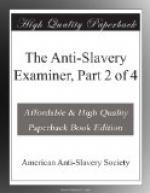At short intervals were seen the buildings of the different estates thrown together in small groups, consisting of the manager’s mansion and out-houses, negro huts, boiling house, cooling houses, distillery, and windmill. The mansion is generally on an elevated spot, commanding a view of the estate and surrounding country. The cane fields presented a novel appearance—being without fences of any description. Even those fields which lie bordering on the highways, are wholly unprotected by hedge, ditch, or rails. This is from necessity. Wooden fences they cannot have, for lack of timber. Hedges are not used, because they are found to withdraw the moisture from the canes. To prevent depredations, there are watchmen on every estate employed both day and night. There are also stock keepers employed by day in keeping the cattle within proper grazing limits. As each estate guards its own stock by day and folds them by night, the fields are in little danger.
We passed great numbers of negroes on the road, loaded with every kind of commodity for the town market. The head is the beast of burthen among the negroes throughout the West Indies. Whatever the load, whether it be trifling or valuable, strong or frail, it is consigned to the head, both for safe keeping and for transportation. While the head is thus taxed, the hands hang useless by the side, or are busied in gesticulating, as the people chat together along the way. The negroes we passed were all decently clad. They uniformly stopped as they came opposite to us, to pay the usual civilities. This the men did by touching their hats and bowing, and the women, by making a low courtesy, and adding, sometimes, “howdy, massa,” or “mornin’, massa.” We passed several loaded wagons, drawn by three, four, or five yoke of oxen, and in every instance the driver, so far from manifesting any disposition “insolently” to crowd us off the road, or to contend for his part of it, turned his team aside, leaving us double room to go by, and sometimes stopping until we had passed.
We were kindly received at Millar’s by Mr. Bourne, the manager. Millar’s is one of the first estates in Antigua. The last year it made the largest sugar crop on the island. Mr. B. took us before breakfast to view the estate. On the way, he remarked that we had visited the island at a very unfavorable time for seeing the cultivation of it, as every thing was suffering greatly from the drought. There had not been a single copious rain, such as would “make the water run,” since the first of March previous. As we approached the laborers, the manager pointed out one company of ten, who were at work with their hoes by the side of the road, while a larger one of thirty were in the middle of the field. They greeted us in the most friendly manner. The manager spoke kindly to them, encouraging them to be industrious He stopped a moment to explain to us the process of cane-holing. The field is first ploughed[A] in one direction, and




